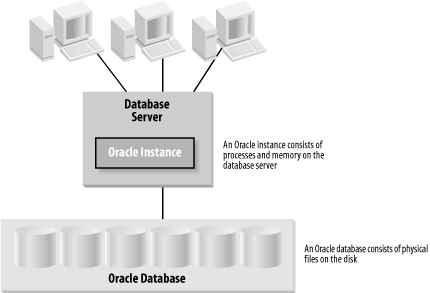Chapter 2. Oracle Architecture
This chapter focuses on the concepts and structures at the core of the Oracle database. When you understand the architecture of the Oracle server, you’ll have a context for understanding the rest of the features of Oracle.
Instances and Databases
Many Oracle practitioners use the terms “instance” and “database” interchangeably. In fact, an instance and a database are different (but related) entities. This distinction is important because it provides insight into Oracle’s architecture.
In Oracle, the term database refers to the physical storage of information, and the term instance refers to the software executing on the server that provides access to the information in the database. The instance runs on the computer or server; the database is stored on the disks attached to the server. Figure 2-1 illustrates this relationship.
 |
The database is physical: it consists of files stored on disks. The instance is logical: it consists of in-memory structures and processes on the server. For example, Oracle uses an area of shared memory called the System Global Area (SGA) and a private memory area for each process called the Program Global Area (PGA). (The SGA is discussed further later in this chapter and both the SGA and PGA are further discussed in Chapter 6.) An instance can connect to one and only one database, although ...
Get Oracle Essentials, 3rd Edition now with the O’Reilly learning platform.
O’Reilly members experience books, live events, courses curated by job role, and more from O’Reilly and nearly 200 top publishers.

